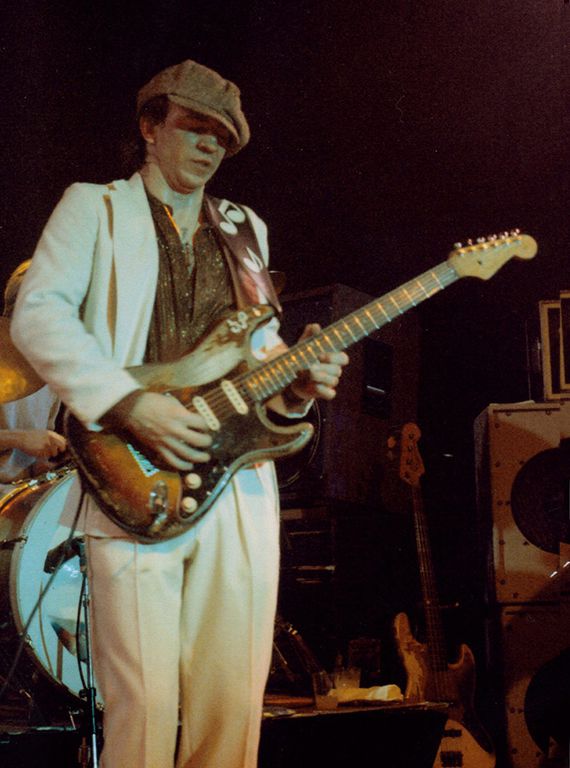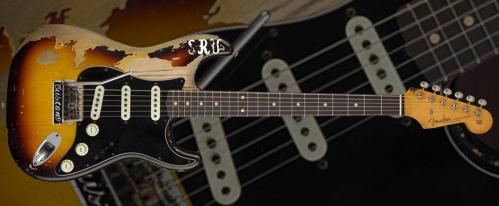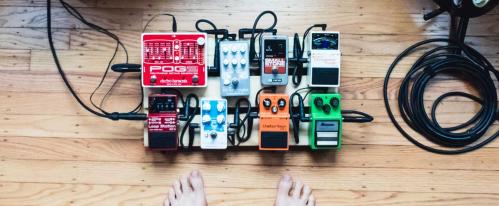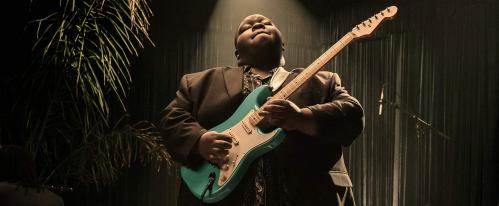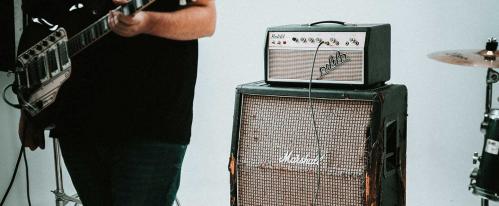We take a look at how SRV got his signature sound and give you a quick Stevie Ray Vaughan gear guide.
Okay, Stevie Ray Vaughan’s tone was massive. And an entire industry has practically grown up around assisting players in replicating that monster of a sound, so let's look at what you can achieve in this realm, and what you can’t.
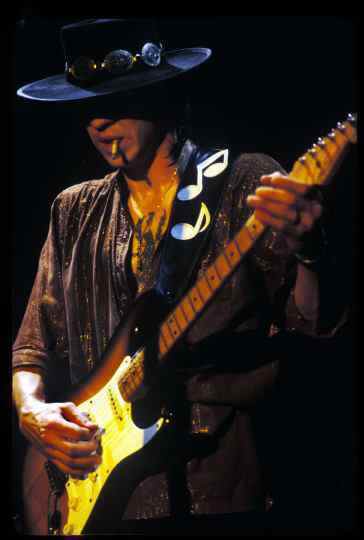
As with most legendary players, the ingredients of SRV’s sound can be broken down into three categories: guitars, amps, and pedals.
In his case, this represents a descending order of the intensity with which his gear is analyzed. Let’s take one chunk at a time, analyze some of the little myths that surround them, and see where it gets us. SRV played several guitars throughout his career, but far and away his favorite and the most played was the one he called “Number One,” which was purchased in the mid 1970s at Ray Hennig’s Heart of Texas Music Store in Austin, Texas.
This guitar is often described as being a 1959 Fender Stratocaster with a slab rosewood fingerboard, a reference that has helped to give Strats of this vintage an extra cache on the collector’s market. Even though Vaughan himself referred to it as such on occasions, both the neck and body of this famous battered Stratocaster were from 1962, and were dated as such in the neck pocket and on the end of the neck respectively, as testified to by long-time SRV guitar tech Rene Martinez in occasional interviews.
The pickups themselves, however, were indeed dated 1959, although whether they were replacements or just a stock set that Fender was late in taking off the shelf to join up with the ’62 neck and body is not entirely clear. Does the guitar’s precise vintage matter? Not a whole lot. Regardless of SRV’s connection a 1959 Stratocaster retains a certain collector’s appeal because it demarks the first year of the rosewood fingerboard, but so-called “slab” rosewood fingerboards (thicker boards, with a flat bottom, rather than the thinner “veneer” boards that followed) were still being used into 1962 — and Fender neck profiles varied quite a bit anyway — so Strats from 1959 and 1962 might not be radically different, from the average player’s perspective.
In any case, “Number One” was far from original, and if not for its SRV associations would have become the type of vintage guitar that collector’s turn their noses up at. Vaughan preferred Dunlop jumbo frets on his guitars, and this Strat had been refretted with them so many times (due to the extreme use it experienced) that the upper reaches of the fingerboard were migrating from the original 7 1/4” to a flatter 9” radius (as measured and reported by luthier and writer Dan Erlewine in The Guitar Player Repair Guide).
This is another alteration that would send a collector running, but the flatter radius actually would have made it easier to bend strings without choking out on the curve of the vintage-spec board. Much is made, too, of the left-handed vibrato tailpiece that was fitted to “Number One” in Vaughan’s early ownership of the guitar, and the fact that this replicated the action of the right handed vibrato tailpiece on the Stratocaster’s played by Jimi Hendrix, who was much admired by Vaughan.
The modification certainly makes for a slightly different feeling vibrato unit, but we have it on good authority that this change was actually more random than calculated. It’s Rene Martinez again who tells us that, in fact, that the left-handed vibrato was the only one in stock when the original needed to be replaced. Also, the black three-ply pickguard — with reflective stickers — was definitely a replacement, although prior to the recording of the Texas Flood album SRV was pictured with his “Number One” Strat still with its original white pickguard.
It’s also worth noting that yet another black replacement ’guard, a full new set of gold-plated hardware, and a replacement neck were all installed on “Number One” around 1990, the neck in particular being just too worn out to be refretted yet again.
A lot is also made of the fact that SRV used very large strings, usually gauged .013 to .058, and certainly bigger strings do transmit a bigger signal through the pickups. Note, however, that Jimi Hendrix used a relatively thin .009 set, but he didn’t sound small by any standards. Also, Vaughan tuned down a half-step to Eb, and lessening the strings’ tension to that extent equates to a playing feel of a string gauge lighter, roughly speaking.
Was there magic in Stevie Ray Vaughan’s Number One Stratocaster? He clearly loved it himself, but he sounded just as much like SRV when it still had the white pickguard and right-handed vibrato in the late ’70s, or the entirely new neck in 1990. So maybe it was his amp(s) that made all the difference?
Amps
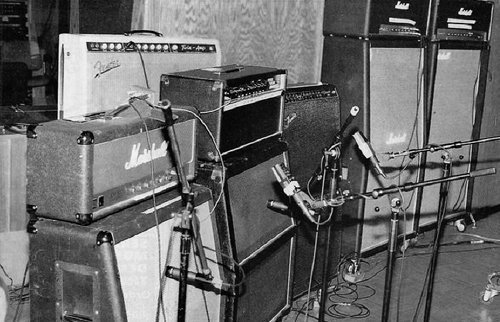
In the early days, Vaughan played mostly ’60s or early ’70s Fender tube amps, usually two at a time, and rotated between Vibroverbs, Twin Reverbs, and Super Reverbs.
At some point he also acquired a 100-watt Marshall Town & Country 2x12 combo and often subbed that into the pair.
You can already hear a big sound brewing, but however you mix and match the amplifier contingent he always sounded like Stevie Ray Vaughan.
His legendary amp excesses set in during the recording of In Step, when — according to amp tech Cesar Diaz — as many as 32 amps were up and running around the studio, used in varying combinations on different tracks.
Among these, in addition to those already listed, were a 150-watt Dumble Steel String Singer, a vintage 1959 Fender tweed Bassman, and a pair of massive 200-watt Marshal Major stacks.
Fans have gone to great lengths to obtain that huge and driven — yet perplexingly clear — SRV amp tone, and plenty have constructed some complex and expensive multi-amp rigs to do so, but before you set out to nail that In Step tone for yourself, consider the possible permutations of those 32 amps … and the fact that no one really knows anymore which ones, or how many, were used on which tracks.
There are plenty of reports of Vaughan being invited up on stage with other players and using their guitar and single amp, and ripping it up — and sounding just like SRV in the process.

Vaughan also dabbled with a range of pedals, but his mainstay for overdrive was an Ibanez Tube Screamer.
The original TS-808 Tube Screamer has become a major collector’s item, and a good one can fetch upwards of $500 on the vintage market.
Thanks to SRV? Not necessarily… having started with the desirable but less precious TS-9, he was using an entirely mundane TS-10 by the end of his career, and you can pick up an original example of that one for under £100 on the second hand market if you keep your eyes peeled.
They are decent sounding overdrive pedals, but no great mystery or rarity, and many players feel the template has been far surpassed by plenty of newer makes and models anyway.
Add it all up, and however massive SRV’s tone — and it undeniably was — this cornucopia of elements and ingredients shows you there’s no clear gear-based magic to the formula. The man played hard and he played well, and a big, big sound came out. [originally by Dave Hunter, Gibson.com]
Get the Stevie Ray Vaughan Sound:

As the previous article shows, there's more to a guitarist's tone than the gear he uses...but this setup would give you a basic SRV tone - and, at very least, a great sound!
STEVIE RAY VAUGHAN STYLE GUITARS
As far as guitars go, you have a couple of different options in terms of cost and set up, but you'll absolutely NEED a fender Stratocaster to get that SRV sound. The Fender Custom Shop 62 Stratocaster Relic Ash Body, 2 Tone Sunburst is quite possibly one of the most beautiful guitars we've ever seen and looks just like the guitars SRV used to play complete with dark tortoiseshell pickguard, white pickups and tone/volume knobs.
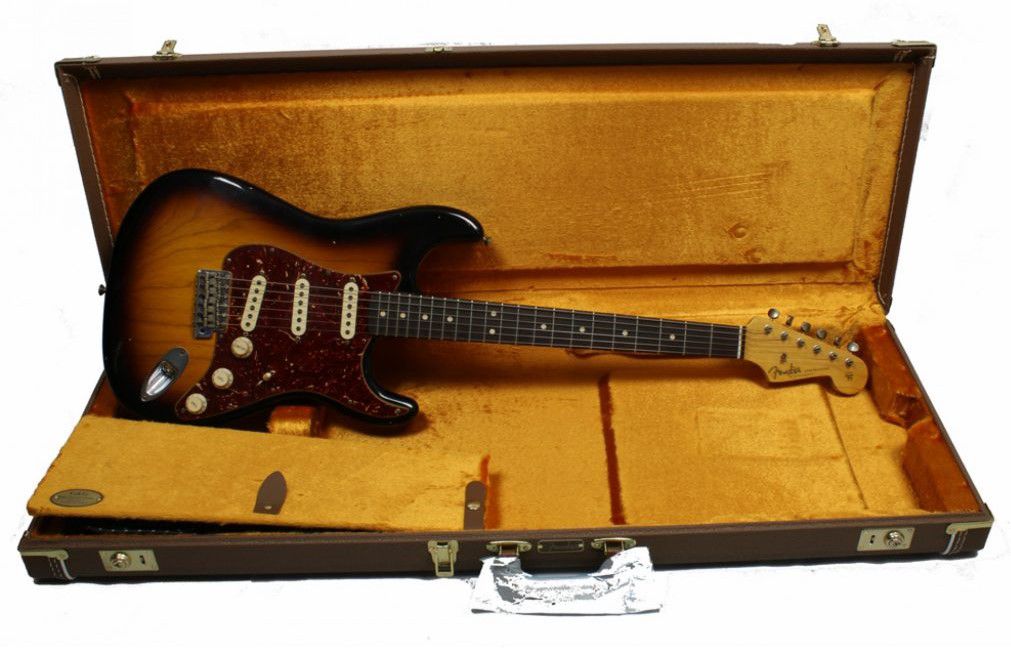
If you want something a little more budget friendly, the Fender American Professional Stratocaster RW, 3-Tone Sunburst is another fine guitar that'll help you get to SRV tone territory.
Fender have raised their already impeccable game with these guitars by installing V-Mod single-coil pickups that eliminate that annoying single coil hum as well as treble bleed circuitry to retain your attack at all volumes.

STEVIE RAY VAUGHAN EFFECTS PEDALS
As previously discussed, there's only one style of pedal you need to get that SRV tone, and that's the Ibanez TubeScreamer. Now, bear in mind that there's a few different versions out there, all of which have their unique sounds and sonic differences, but the TS9 and/or TS808 reissue are the pedals you need.

The Ibanez TS-9 Tubescreamer is a classic guitar pedal that has achieved superstar status in th world of effects pedals thanks to its ease of use, great sound and ability to make your valve amps sound absolutely amazing.
Whereas most guitar pedals will colour your sound to the point that your original guitar tone is lost, this takes what you've got and pushes it harder, adding some subtle nuances to your sound, but bringing out the best in your amp and guitar.
If you're a SRV and you don't have one of these you need to have a word with yourself.

The Ibanez TS808 Tubescreamer Reissue Guitar Effects Pedal is described as "the Holy Grail of Tube screamers" owing to the fact that its a faithful reissue of the original pedals.
It's also got the coveted JRC4558 chip built-in for those classic warm tube vibes. Bang this on and bust out some SRV licks! To complement your setup, you can also use the new Dunlop Jimi Hendrix signature pedals: Dunlop Jimi Hendrix Cry Baby Mini Wah Pedal, Dunlop Jimi Hendrix Fuzz Face, Dunlop Jimi Hendrix Octavio Fuzz Pedal.
His setup was inspired a LOT by Hendrix, and like Hendrix, he used the original versions of those 3 FX pedals.
STEVIE RAY VAUGHAN GUITAR AMPS
Stevie favoured his 1964 fender Vibroverb, but unfortunately getting hold of one of those is probably going to cost you a small fortune. However, if you want a reliable, loud and beautiful sounding amp that can give you gorgeous cleans, a little dirt when you need it and has some reverb built in, we recommend the Fender 68 Custom Vibrolux Reverb Guitar Amp Combo.

Steve Ray Vaughan never played it, but it's definitely in the same territory and will respond beautifully to your Stratocaster and Tubescreamer!

